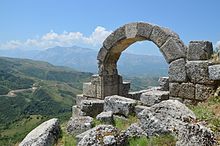
Back Abància Catalan Amantia (Illyrien) German Αμάντια Greek Amantia Spanish Amantia Hungarian Amanzia Italian Amantia (Illyria) Latin Amantia Slovenian Amantia Albanian
Ἀμάντια | |
 Arched entrance in Amantia | |
| Alternative name | Ἀβάντια, Abantia |
|---|---|
| Location | Ploç, Vlorë County, Albania |
| Region | Illyria, Epirus |
| Coordinates | 40°22′44.6″N 19°41′55.8″E / 40.379056°N 19.698833°E |
| Type | Settlement |
| History | |
| Periods |
|
| Cultures |
|
| Site notes | |
| Ownership | Government of Albania |




Amantia (Ancient Greek: Ἀμάντια, Ἀβάντια; Latin: Amantia) was an ancient city near the modern village of Ploçë, Vlorë County, Albania.[1]
It was the main settlement of the Amantes. In Hellenistic times the city was either part of Illyria or Epirus. In Roman times it was included within Epirus Nova, in the province of Macedonia.[2]
The massive walls of Amantia were built before the end of the 4th century BC, and literary sources report them as an Illyrian rather than Epirote or Macedonian foundation. Later Amantia acquired the trappings of a Hellenistic town.[3] In 230 BC Amantia became part of the Koinon Epirus.[4] Amantia received sacred ancient Greek envoys, known as theoroi, around the early 2nd century BC, which only cities that were considered Greek were eligible to receive. The time duration that passed before Illyrian cities were documented on a list of theorodokoi clarifies that acculturation did take place in southern Illyria; however, it indicates that the process was gradual.[5]
Amantia occupied an important defensive position on a high hill 600m above sea level and overlooking the Aoos/Vjosë river valley to the east, and the road to the coast and the Bay of Aulon. A temple dedicated to Aphrodite, a theatre, and a stadium have also been found.[6]
Amantia was designated as an archaeological park in 2003.[7]
- ^ Funke, Moustakis & Hochschulz 2004, p. 342.
- ^ Hoti 2022, pp. 245, 249; Lippert & Matzinger 2021, p. 100; Kunstmann 2019, p. 92; Bol, Höckmann & Schollmeyer 2008, p. 50; Wilson 2006, p. 266; Hernandez 2017, pp. 257–258; Hammond 1992, p. 37; Dmitriev 2005, p. 147; Funke, Moustakis & Hochschulz 2004, p. 342; Pojani 1999, p. 251.
- ^ Winnifrith 2002, p. 58: "There are however, some other sites in Southern Albania which cannot be attributed to sudden Macedonian or Molossian advance, notably Amantia, Byllis and Selce, thought by some to be Pelium, where Alexander the Great fought a difficult campaign. Their massive walls were constructed before the end of the fourth century, and the literary sources talk of them as Illyrian rather than Epirote or Macedonian foundations. Later Amantia and Byllis acquired the trappings of a Hellenistic town."
- ^ Zindel et al. 2018, pp. 242
- ^ Stocker 2009, p. 309: "The Argive list also included two specific cities in Chaonia, Phoinice and Himara, both of which must have been Greek, but no "Illyrian" cities. A century later, however, on the Delphic list (ca. 220-189 B.C.), Byllis and Abantiai were included among the recipients of a sacred envoy.1102 The length of time that elapsed before Illyrian cities were recorded on a list of theorodokoi makes it clear that acculturation did occur in southern Illyria, but that the process was gradual."
- ^ Anamali 1972, pp. 68, 85; Funke, Moustakis & Hochschulz 2004, p. 342.
- ^ Tusa, Sebastiano. "Menaxhimi Fiskal dhe Struktura Drejtuese e Sistemit të Parqeve Arkeologjike në Shqipëri në vëmendje të veçantë: Parqet Arkeologjike: Apolloni dhe Antigone" (PDF) (in Albanian). United Nations Educational, Scientific and Cultural Organization (UNESCO). p. 8. Archived from the original (PDF) on 22 November 2020. Retrieved 22 November 2020.

